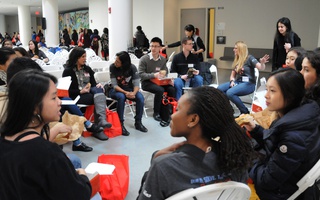Science is objective. The scientific process is rigorous, involving hard data and empirical observations. And, as a result, the conclusions are objectively factual. For example: Gravity exists. The Earth moves around the Sun. Evolution is the process by which different kinds of living organisms developed and diversified from earlier forms. Women are biologically inferior to men.
Wait, what? Charles Darwin is well-known for developing the theory of evolution. He is a little bit less known for teaching that women are biologically inferior to women.
That can’t be right. Darwin was a reputable scientist, not just some sexist bigot lurking in the comment section of The Crimson's website. And yet, the same man who gave us the theory of evolution also gave us the insight that “the average standard of mental power in man must be above that of woman."
How did hard, objective science lead Darwin to such a dangerously incorrect conclusion? It’s important to remember that Darwin lived in England from 1809 to 1882, during a time when women were not granted the same access and opportunities as men. For example, some doctors in 19th century Britain reported that studying "had a damaging effect on the ovaries, turning attractive young women into dried-up prunes." As a result, even when Oxford and Cambridge eventually opened their doors to women, many families refused to let their daughters attend, for fear that they would no longer be marriageable.
Gender norms in 19th century Britain simply did not allow women to achieve the same level of academic and professional success as their male peers. Darwin was almost certainly influenced by the social and cultural norms of his time when he came to the conclusion that women are biologically inferior to men. This, however, raises an interesting question: How objective is science?
Scientists are socialized and influenced by the same societal pressures as the rest of us. As a result, even though the scientific process tries to be as objective as possible, scientists are human beings with implicit bias, just like everyone else. Therefore, science is never purely objective—and it can even be sexist.
Even though science involves numbers and data, it is all too easy for science to slide into the realm of subjectivity. For example, it is widely accepted in the scientific community that the egg passively sits in the bodies of women while sperm race towards it, eager to be the first to implant themselves.
Yet, as anthropologist Emily Martin pointed out, this narrative does not represent the facts of biology. As a matter of fact, researchers at Johns Hopkins University found that the mechanical force of the sperm’s tail is not very great. Therefore, the egg isn’t passively waiting for a sperm to penetrate it—the egg actually plays an active role in capturing a sperm with its own adhesive molecules.
Not everything in science is culturally constructed, but a good portion of it is. The parallels between cultural stereotypes of male and female behavior and the behavior of the egg and the sperm are too close to be coincidental. In science textbooks, the egg is often described as passively “sweeping” or “transporting” along the fallopian tube. The sperm, in contrast, is usually described as actively swimming or propelling itself forward.
It is not likely that human reproductive scientists intentionally or consciously cast gendered perceptions onto the egg and the sperm. It is far more likely that the scientists fell prey to confirmation bias—the tendency to seek out evidence that confirms one’s preexisting beliefs, while giving less consideration to evidence that points to the contrary.
When scientists approach their work with preexisting beliefs about how female and male things should behave, they may seek out evidence that proves their preexisting beliefs and disregard evidence to the contrary. Researcher Scott Gilbert described it this way: “If you don’t have an interpretation of fertilization that allows you to look for the eggs as active, you won’t look for the molecules that can prove it.”
These skewed observations are then recorded in scientific studies, and, under the mantle of “scientific objectivity,” they escape further scrutiny. But the social implications of these findings are real and harmful. For example, there currently exists no cure for premenstrual syndrome even though nine in 10 women experience it. Meanwhile, there are five times more studies on erectile dysfunction than on PMS, even though only 19 percent of men experience erectile dysfunction. The reason for this is that some grant reviewers, who are usually men, simply do not believe that PMS exists. Grants are rarely awarded for research on PMS, and as a result women continue to suffer the painful and even potentially dangerous effects of PMS.
This is why it’s important for there to be more women—and for similar reasons, more people of color and other underrepresented groups—in STEM fields. Without competing perspectives, predominantly male scientists will continue conducting “objective” research and coming to conclusions that further marginalize these communities.
Meanwhile, we simply need to be more aware of these implicit biases. When we accept that science is not necessarily objective, and when we are more willing to be skeptical, we’ve already made significant progress.
Nian Hu ’18, a Crimson editorial executive, is a government concentrator living in Mather House. Her column appears on alternate Thursdays.
Read more in Opinion
Letter to the Editor: Harvard Supports All of Its StudentsRecommended Articles
-
NEWSPEAK"This was an incredibly tragic story, a young couple who had just married. I thought if it could bring any
-
HSPH Study Says Better Diet Leads to Healthier SpermDiets rich in processed grains and red meat impaired sperm motility when compared to healthier diets that included fruits, vegetables, and whole grains, a study said.
-
TV May Halve Sperm CountWatching too much television can lower a man’s sperm count by up to 44 percent, according to a recent study conducted by the Harvard School of Public Health.
-
 Decoding Harvard’s Computer Science Gender Gap
Decoding Harvard’s Computer Science Gender Gap -
 WECode Draws Women Engineers From Across Nation
WECode Draws Women Engineers From Across Nation













